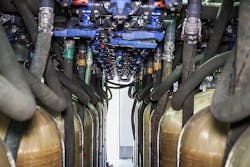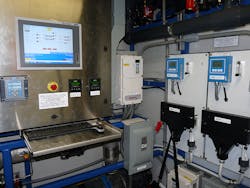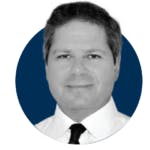Considerations for implementing a zero liquid discharge program
In recent years, pressure from U.S. regulatory bodies and increased water and wastewater costs have prompted many plant leaders at industrial operations to investigate ways to limit their water usage while also protecting their bottom line. To achieve this, some companies — especially those in drought-stricken regions — are transitioning to a zero liquid discharge (ZLD) treatment program. While every industrial operation will use wastewater treatment technology in some fashion, ZLD is much more ambitious, aiming for total or near total reuse of water resources. Before implementing a ZLD system at an industrial operation, several factors must be considered to determine if an all-solid output is both necessary and cost effective.
What is zero liquid discharge and where is it used?
Zero liquid discharge is an expanding water treatment philosophy in which wastewater is purified and recycled, leaving little to no effluent remaining when the process is complete. Although the treatment requirements will largely depend on the application, ZLD often includes reverse osmosis, ultrafiltration, evaporation and various other membrane technologies.
“Although the treatment requirements will largely depend on the application, ZLD often includes reverse osmosis, ultrafiltration, evaporation and various other membrane technologies.”
ZLD has become common practice for wastewater treatment in places like Europe and Australia where populations continue to rise and water is in short supply. Comparatively, most regions in the U.S. have been slower to adopt such programs because of the country’s abundant water resources. Currently, states in the western part of the U.S. are implementing ZLD more frequently than their eastern counterparts because of their proximity to viable water resources.
Overall, the world is trending toward less water usage due to advancements in environmental research and water consumption projections, making the need for ZLD and related systems more prevalent.
Why would a facility want to adhere to the zero liquid discharge limits?
Although many influences are at play, the key driver in any industry is always cost.
Typically, the least expensive option is to simply eliminate wastewater in a sewer or other waste resource, but if sewer access is not possible, the price for disposal can quickly become cost prohibitive. Plus, the costs of wastewater treatment and discharging can be a burden, driving industry leaders to rethink ZLD.
Regulatory compliance can be a factor as well. Some states have strict discharge standards, which direct plant operations to resort to ZLD. Other regulatory bodies, such as the U.S. Environmental Protection Agency (EPA), have made strides toward making ZLD the preferred wastewater treatment method because it reduces the industry’s impact on the environment. In fact, in 2015, the EPA amended regulations1 covering wastewater discharges from power plants specifically, in an effort to reduce chemical and thermal pollutants from infiltrating water supplies.
Stricter regulations have also given rise to a greater need for outside vendor support because the costs and required experience to operate specialized ZLD equipment can be quite high. In other words, it’s often more cost effective to source externally, allowing existing employees and resources to focus on the core business (i.e., a power company is not in the water business; they are in the power business). Many new operations are outsourcing treatment as a cost-effective alternative to building water treatment systems into the facility’s initial design; however, companies that seek help from outside resources should make sure the vendor is properly equipped for long-term support.
Modern ZLD systems come fully automated with continuous monitoring instrumentation to ensure optimal operation.
It’s important to note that most ZLD systems in the U.S. do not recover 100 percent of wastewater, yet they are still highly effective. Commonly referred to as near-ZLD, these programs recover between 70 and 90 percent of wastewater for reuse. Based on a plant’s immediate needs, regulatory requirements and overall financial goals, near-ZLD is a good option.
What is a typical use case for zero liquid discharge?
The objective at all ZLD sites is to reuse as much water as possible. There is no preset solution for ZLD programs, and even systems that have been proven to work in certain operating environments may require additional customization for optimal performance. Although every industry, plant and on-site team will adopt ZLD programs for different reasons, certain trends exist in the marketplace today that have prompted more widespread use.
For instance, the power industry has seen a greater shift toward ZLD in recent years due to stricter discharge guidelines and overall public perception of the industry’s environmental impact. In fact, recent studies2 show that the power generation segment is dominating the ZLD market, accounting for more than 30 percent of global market share. In addition, power plants require large amounts of water to support day-to-day operations, making it even more important to find effective ways to reuse this resource.
“The power industry has seen a greater shift toward ZLD in recent years due to stricter discharge guidelines and overall public perception of the industry’s environmental impact.”
A typical power plant utilizing ZLD design will pull water from a water source to supply the cooling tower. When the water evaporates during cooling tower cycling and heat is removed, minerals are still present in the remaining water, leaving it with a high concentration of total dissolved solids (TDS). In recent years, methods have been developed to further increase cooling tower cycles into the low teens, thereby increasing TDS levels while also reducing the amount of fresh replacement water to maintain cooling tower makeup. Cooling tower discharge with very high TDS is called cooling tower blowdown. In areas where water is scarce, every drop is critical, which is why the reuse of cooling tower blowdown water was first introduced.
To meet ZLD requirements, many companies use a brine concentrator system to treat cooling tower blowdown water. When implemented correctly, such systems provide 70 to 80 percent recovery — and nearly 100 percent when crystallizers are incorporated. However, despite the high recovery rate, such systems also have high operating costs and can be challenging to maintain. In this case, it may be prudent to consider different treatment methods with less financial and time constraints. For example, industry leaders and specialized operators in ZLD are designing customized solutions that use state-of-the-art membrane equipment, including ultrafiltration and high-recovery reverse osmosis, to obtain specific treatment goals while also achieving high water recovery rates. The solution can then be deployed for either mobile backup during system outages or as an outsourced system or capital expenditure (capex) with service.
Ultrafiltration systems support the ZLD process by removing high levels of total suspended solids (TSS). MPW’s Ultrafiltration trailer system provides up to 800 gpm of filtered water from a variety of influent water sources to meet or exceed requirements.
In addition to the power generation sector, ZLD programs are becoming more common in industries that are inherently highly regulated or that require a steady water supply, such as chemical, food and beverage, pharmaceutical, steel and pulp and paper, as well as certain remediation projects.
ZLD has also become popular among inland desalination plants, specifically for brine management. Normally, the simplest way for plants to handle brine is to discharge into seawater; however, if an ocean is not nearby, ZLD becomes an attractive option. Because of advancements in ZLD, company owners are no longer bound to building desalination plants along a coastline.
Consider zero liquid discharge goals
Because there is no one-size-fits-all solution for ZLD projects, mapping out operational goals and understanding the financial return on investment is key to ZLD success. In addition, finding a partner that can assist with system design helps ensure the program will be tailored to a specific facility. For operations with large volumes of water to process, a turnkey, customized ZLD program helps reduce a company’s environmental footprint as well as operating costs.
References
1. Steam Electric Power Generating Effluent Guidelines: https://www.epa.gov/eg/steam-electric-power-generating-effluent-guidelines
2. Global Market Study on Zero Liquid Discharge: Power Generation and Chemicals & Petrochemicals Segments by Application Projected to Dominate the Global Market During the Forecast Period: https://www.persistencemarketresearch.com/market-research/zero-liquid-discharge-market.asp.
Mark Bornhoft, PE, has more than 30 years of experience in process industry operations, serving 20 years as a plant manager. He is an area sales manager for MPW Industrial Services. Bornhoft holds a Bachelor of Science in mechanical engineering from the South Dakota School of Mines & Technology and a Professional Engineering license. He can be reached at [email protected].
Peter Takach has more than 35 years of experience in process engineering and system development. He is a technical services engineer at MPW Industrial Services, supporting four area sales managers in developing industrial water opportunities. Takach also helps lead MPW’s Build-Own-Operate-Maintain (BOOM) program — a turnkey solution for on-site water treatment. He holds a Bachelor of Science in environmental design and planning from the University at Buffalo, and he has a patent for the manufacture of an aperture mask. Takach can be reached at [email protected].




